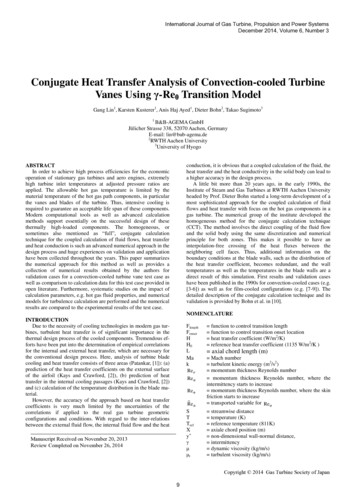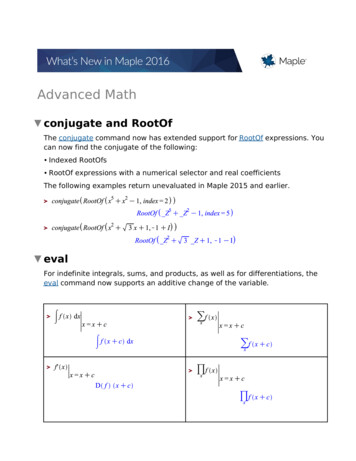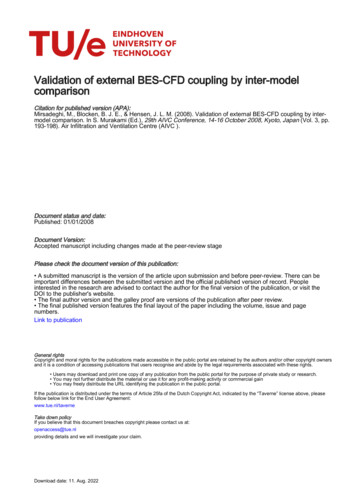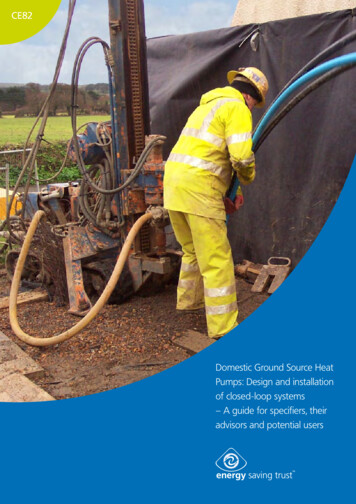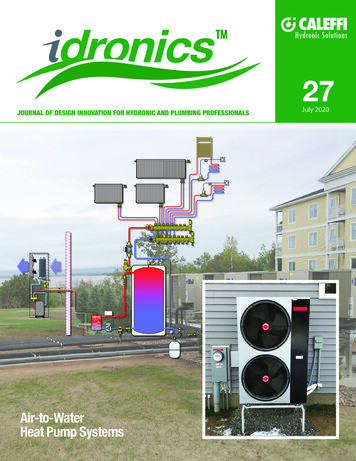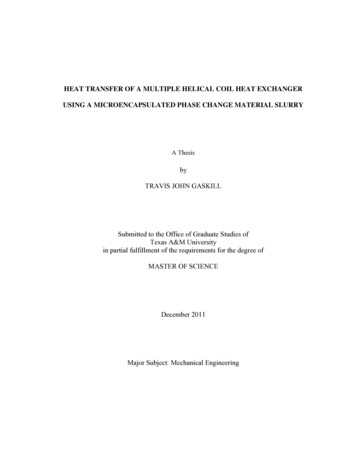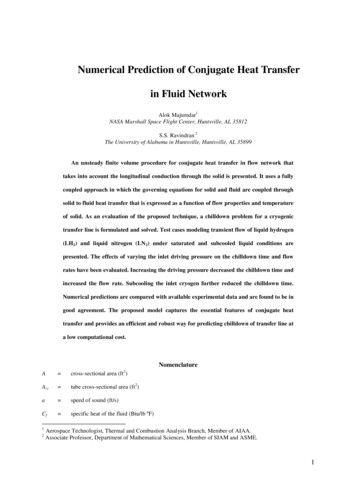
Transcription
Numerical Prediction of Conjugate Heat Transferin Fluid NetworkAlok Majumdar1NASA Marshall Space Flight Center, Huntsville, AL 35812S.S. Ravindran 2The University of Alabama in Huntsville, Huntsville, AL 35899An unsteady finite volume procedure for conjugate heat transfer in flow network thattakes into account the longitudinal conduction through the solid is presented. It uses a fullycoupled approach in which the governing equations for solid and fluid are coupled throughsolid to fluid heat transfer that is expressed as a function of flow properties and temperatureof solid. As an evaluation of the proposed technique, a chilldown problem for a cryogenictransfer line is formulated and solved. Test cases modeling transient flow of liquid hydrogen(LH2) and liquid nitrogen (LN2) under saturated and subcooled liquid conditions arepresented. The effects of varying the inlet driving pressure on the chilldown time and flowrates have been evaluated. Increasing the driving pressure decreased the chilldown time andincreased the flow rate. Subcooling the inlet cryogen further reduced the chilldown time.Numerical predictions are compared with available experimental data and are found to be ingood agreement. The proposed model captures the essential features of conjugate heattransfer and provides an efficient and robust way for predicting chilldown of transfer line ata low computational cost.NomenclatureA cross-sectional area (ft2)Acc tube cross-sectional area (ft2)a speed of sound (ft/s)Cf specific heat of the fluid (Btu/lb ºF)12Aerospace Technologist, Thermal and Combustion Analysis Branch, Member of AIAA.Associate Professor, Department of Mathematical Sciences, Member of SIAM and ASME.1
CL flow coefficientCp specific heat at constant pressure (Btu/lb ºF)c wave speed (ft/s)D diameter of the pipe (ft)f* Darcy-Weisback friction factorgc gravitational constant (32.174 lb-ft/lbf.s2)h enthalpy (Btu/lb)hc heat transfer coefficient (Btu/ft2–s ºF)J mechanical equivalent of heat ( 778 ft-lbf /Btu)Kf * flow resistance coefficient (lbf-s2/(lb-ft)2)Krot nondimensional rotating flow resistance coefficientk thermal conductivity (Btu/(ft-s ºF)L length of the tube (ft)m& mass flow rate (lb/s)m resident mass (lb)Nu Nusselt numberPr Prandtl numberRe Reynolds numbern number of branchesp pressure (lbf /ft2)Q& heat source (Btu/s)q& heat transfer rate (Btu/s)R gas constant (lbf-ft/lb-R)r radius (ft)S& heat source (Btu/s)S momentum source (lb)T temperature (ºF)t time (s)2
V volume (ft3)v fluid velocity (ft/s)z compressibility factorδ tube wall characteristic length (ft)ε surface roughness of pipe (ft)ρ density (lb/ft3)φ specific volume, specific heat, or viscositySubscriptsf liquid stateg vapor statei ith nodeij branch connecting nodes i and jj jth nodes solid nodesa solid to ambientsf solid to fluidss solid to solidu upstreamI.IntroductionCONJUGATE heat transfer problem is a coupled, fluid-structure, heat transfer problem where conduction heattransfer in a solid wall interacts with fluid flow and the convection heat transfer in fluid flow interacts at the solidboundary. Fluid network modeling with conjugate heat transfer has many applications in aerospace engineering andothers. In modeling unsteady flow with heat transfer, it is important to know the variation of wall temperature intime and space to be able to calculate heat transfer from solid to fluid. Since wall temperature is a function of flow, acoupled analysis of temperature of solid and fluid is necessary.In cryogenic applications, such as medical and space technology, modeling of conjugate heat transfer is of greatimportance. In space technology applications, correct prediction of boil-off rate in propellant tanks and chilldown of3
transfer lines are of great engineering value. The operation of a cryogenic propulsion system, such as those found inspacecraft and missiles, requires transfer line chilldown before establishing a steady flow of cryogenic fluid betweenvarious system components. The primary objective is to cool the line (Fig. 1) as fast as possible so as to attainhomogeneous liquid transfer. When liquid cryogen at saturation temperature begins to flow in a tube, initially atambient temperature, the liquid instantly vaporizes near the tube wall. Therefore, a cross section of the flow willhave an outer vapor ring with a saturated liquid core. As the flow moves downstream, the liquid core evaporates,and the vapor becomes superheated. As the tube wall cools, the liquid core penetrates farther and beyonddownstream. Eventually, the tube becomes filled with liquid. Due to change in fluid density, the average velocitiesare significantly higher in the vapor region of the tube. Prediction of chilldown time requires modeling of thesetransient phenomena and understanding of how they affect heat transfer from the tube wall to the flowing cryogen.Several experimental and computational studies of the chilldown of various types of transfer lines have beenreported in the literature [1–12]. In [4], chilldown of an LN2 flow in a vertical tube was experimentally investigated.Experimental studies into the chilldown of a horizontal tube by an LN2 flow with low mass flow rates werepresented in [11]. In [10], experimental investigations into the heat transfer characteristics and flow regimes ofnitrogen and hydrogen were presented. In [6], an analytical model of the chilldown was presented under theassumption of constant flow rate, heat transfer coefficient, and fluid properties. In [7], a numerical modeling of aone-dimensional chilldown process was presented using a finite difference method. In [5], a finite volume-basednumerical modeling was presented for prediction of the chilldown of a cryogenic transfer line, based only ontransient heat transfer effects and neglecting fluid transient effects. Subsequently, it was extended to include fluidtransient effects in [8]. Conjugate heat transfer analysis presented in [5] and [8] modeled the solid nodes in an ad hocmanner in which conservation equations for solid were solved at the beginning of each time step and solidtemperatures were used to calculate heat transfer to the fluid node. Although successful comparison of numericalsolution with analytical solution for a short tube was reported in [5], the results presented in [8] for a long tube didnot match the experimental data well. The mismatch is partly due to the semi-coupled, fluid-solid heat transfermodeling and partly due to the fact that longitudinal conduction between solid nodes was not accounted for in theirmodel.The purpose of this paper is to present a fully coupled, fluid-solid network modeling for conjugate heat transferproblems. In network modeling, the conservation equations are first expressed in finite volume form for a network.4
Flow domain is discretized into a series of discrete nodes connected by branches. Each internal node is connected toother solid nodes and the solid nodes are in turn connected to other solid nodes via conductors; see Fig. 2a. In thisframework, conservation equations for both solid and fluids are solved simultaneously using an unsteady networkfinite volume approach. The mass and energy conservation equations are solved at the nodes, whereas momentumconservation equations are solved at the branches. The energy conservation equations for solid nodes are solved todetermine the temperatures of the solid nodes simultaneously with all conservation equations governing fluid flow.However, the simultaneous nonlinear system that arises in network flow modeling with conjugate heat transfer canbe prohibitively large. Therefore, current implementation of some fast algorithms for solving the fully discretesystem of nonlinear conservation equations is presented. The numerical algorithms described in this paper wasimplemented in a general purpose computer program, Generalized Fluid System Simulation Program (GFSSP) [13]and was used to carry out the numerical experiments.The feasibility of the proposed network conjugate heat transfer approach is shown in predicting the chilldown ina long cryogenic transfer line. Two chilldown cases using LH2 and LN2 as the working fluid are studied. Numericalpredictions by the proposed approach are validated by comparing the results with the experimental investigationsreported in [9]. This experiment was initiated to characterize the thermal response of the transfer line using LH2 andLN2 as the fluids for several different conditions. The experimental setup consisted of a 10.59-ft3 (300-L) supplytank, an inlet valve, and a 200-ft- (60.96-m-) long with 0.75-in outside diameter by 0.625-in- (1.59-cm-) insidediameter vacuum-jacketed copper transfer line that exhausted to atmosphere. Three different inlet valves—a 0.75-in(1.91-cm) port ball valve, a 1-in (2.54-m) port globe valve, and a 1-in (2.54-cm) port gate valve—were used in theNational Bureau of Standards experiments. The exit end of the pipe was open to the atmosphere that was 0.82 atm inBoulder, Colorado.The unsteady network finite volume approach for conjugate heat transfer is presented in Sec. II. Computationalresults and discussion are given in Sec. III. Finally, Sec. IV presents some conclusions drawn from the study.II.Finite Volume Formulation of Fluid NetworkGoverning EquationsNumerical modeling of the conjugate heat transfer process in a cryogenic transfer line requires a solution ofunsteady mass, momentum, and energy conservation equations in conjunction with thermodynamic equations of5
state. The finite volume formulation requires that governing equations be written in a conservative form for a flownetwork involving boundary nodes, internal nodes, and branches; see Fig. 2a. The flow domain is divided into adiscrete number of control volumes and the conservation equations of mass, momentum, and energy are determinedfor each control volume. At boundary nodes, pressures and temperatures are prescribed. At internal nodes, pressuresand temperatures are computed by solving time-dependent mass and energy conservation equations. Each internalnode is a control volume where there are inflow and outflow of mass and energy at the boundaries of the controlvolume. Figure 1 shows a long pipeline connected to a tank with a valve placed at the beginning of the pipeline.Flow in a pipe may be considered as a series of discrete fluid nodes connected by branches. One boundary noderepresents the tank, and the other boundary node represents the ambient where the fluid is discharged.The discretization scheme assumes that the flow is driven by the pressure differential between the upstream anddownstream nodes. This is known as the ‘staggered grid’ technique that is extensively used in solving Navier-Stokesequations by the finite volume method [14]. Mass and energy conservation equations are solved at the internal nodesin conjunction with thermodynamic equation of state. Flow rates are computed at the branches by solving the timedependent momentum conservation equation. This process of discretization allows the development of the set ofconservation equations in an unstructured coordinate system. Figure 2a displays a schematic showing adjacentnodes, their connecting branches, and the indexing system used by the network solver.Mass Conservation EquationThe mass conservation equation at the ith node can be expressed as:(m )it t ( mi )t tn& ij mj 1(1)Equation (1) requires that, for the transient formulation, the net mass flow from a given node must equate to the rateof change of mass in the control volume.Energy ConservationThe energy conservation equation for node i, shown in Fig. 2b, can be expressed following the first law ofthermodynamics and using enthalpy as the dependent variable. It can be written as6
( )m h pρ J t t( ) m h pρJ t t n max mij ,0 h j max mij ,0 hi Qij 1 (2)Equation (2) shows that for transient flow, the rate of increase of internal energy in the control volume is equal tothe rate of energy transport into the control volume minus the rate of energy transport from the control volume plus( )any external rate of heat transfer from the solid node q& sf . The max operator used in Eq. (2) is known as an upwinddifferencing scheme and has been extensively employed in the numerical solution of Navier-Stokes equations inconvective heat transfer and fluid flow applications [14]. When the flow direction is not known, this operator allowsthe transport of energy only from its upstream neighbor. In other words, the upstream neighbor influences itsdownstream neighbor but not vice versa.Momentum Conservation EquationThe flow rate in a branch is calculated from the momentum conservation equation which represents the balanceof fluid forces acting on a given branch; see Fig. 2a. Inertia, pressure, and friction are considered in the conservation&ij signifies that theequation. It should also be noted that the flow rate, m& ij , is a vector quantity. A negative value of mflow is directed from the jth node to the ith node:( mu )t t ( mu )tg c t max[mij ,0]( uij uu ) -max[ mij ,0]( ud uij )() (3) p i p j Aij K f mij mij Aij The two terms on the left side of the momentum equation represent the inertia of the fluid. The first term is the timedependent term that must be considered for unsteady calculations. The second term is significant when there is alarge change in area or density from branch to branch. The first term on the right side of the momentum equationrepresents the pressure gradient in the branch. The second term represents the frictional effect. Friction is modeledas a product of Kf*, the square of the flow rate, and area. Kf * is a function of the fluid density in the branch and thenature of flow passage being modeled by the branch. For a pipe with length L and diameter D, Kf* can beexpressed as7
Kf 8 f Lρuπ 2 D5 gc.The Darcy-Weisbach friction factor f* in the definition of Kf* is caculated from the Colebrook equation [20] which isexpressed as ε12.51 , 2 log f 3.7 D Re f where ε/D is the surface roughness factor and Re is the Reynolds number. The density and viscosity for theReynolds number are computed from quality, assuming homogeneous mixture, to account for two phase flow. Themomentum conservation equation also requires knowledge of the density and the viscosity of the fluid within thebranch. These are functions of the temperatures, and pressures, and can be computed using the thermodynamicproperty program in [15] that provides the thermodynamic and transport properties for different fluids.Equation of StateTransient flow calculations require the knowledge of resident mass in a control volume. The resident mass in theith control volume is calculated from the equation of state for real fluids:m pV.RTz(4)The compressibility factor z and temperature T in Eq. (4) are calculated from the thermodynamic property program[15] for a given pressure and enthalpy. The pressure, enthalpy, and resident mass in internal nodes and the flow ratein branches are calculated by solving the fully coupled, nonlinear system of Eqs. (1), (2), (4), and (3), respectively.There is no explicit equation for pressure. The pressure is calculated implicitly from the mass conservation equation.Phase ChangeModeling phase change is fairly straightforward in the present formulation. The vapor quality of saturated liquidvapor mixture is calculated fromx h hfhg h f.Assuming a homogeneous mixture of liquid and vapor, the density, specific heat, and viscosity are computed fromthe following relations:8
φ (1 x )φ f xφg .where φ represents specific volume, specific heat, or viscosity.Energy Conservation Equation for SolidIn fluid-solid network for conjugate heat transfer, solid nodes, ambient nodes, and conductors become part of theflow network. A typical flow network for conjugate heat transfer is shown in Fig. 2b. The energy conservationequation for the solid node is solved in conjunction with all other conservation equations. The energy conservationfor solid node i can be expressed as:( m C p T si ) t t ( m C p T si ) t t n sf n ss js 1 q ss j f 1 q sf n sa ja 1 q sa S i(5)The left-hand side of the equation represents rate of change of temperature of the solid node, i. The right-hand sideof the equation represents the heat transfer from the neighboring node and heat source or sink. The heat transferfrom neighboring solid, fluid, and ambient nodes can be expressed as follows:(jq& ss kij Aij / δij Ts s Tsisss(jq& sf hij f Aijs T f f Tsi),(5a)),(5b))(5c)and(jq& sa hij Aij Ta a Tsi .aaThe heat transfer rate can be expressed as a product of conductance and temperature differential. The conductancefor Eqs. (5a)–(5c) is9
C ij kij Aijsδijss; Cij hij Aij ; Cij hij Aijfffaaa,(5d)swhere effective heat transfer coefficients for solid to fluid and solid to ambient nodes are expressed as:hij hc,ij hr,ijaa( ) (T ) T hr,ij f ,a i 2s2jσ Tf f1εij, f 1εij,sjff Tsi , 1and (T ) T() hr,ij jσ Tf aai 2 s21εij,a 1εij,sjaa Tsi . 1For the heat transfer coefficient specification we will neglect nucleate boiling and employ the modifiedMiropoloski’s correlation [16] for two-phase flow :Nu hcD/kv ,whereNu 0.023(Remix)0.8 (Prv)0.4 (Y),where10
Remix ρuD ρ g ρ 0.4 C pµg 0.4g x (1 x ) , Prg ρ k , and Y 1 0.1 ρ 1 (1 x ) .µ g 1 g 1 The neglect of nucleate boiling in cryogenic flows with large initial wall superheat (difference in temperaturebetween the duct wall and the fluid at saturation), is expected to have only a minor effect on the overall chilldown.The reason for this is that film boiling remains down to a relatively low superheat after most of the cooling hasoccurred. As a result, the amount of heat transfer occurring during nucleate boiling is relatively small whencompared to the total heat transfer given the initial temperature difference between the fluid and structure.Furthermore, since heat flux increases as peak heat flux is approached from minimum heat flux in film boiling, theboiling curve passes through the nucleate boiling regime very quickly.It may be also noted that radiative heat transfer and heat transfer to ambient have not been included in thecomputations presented in this paper because of their negligible effect on chilldown of vacuum jacketed coppertransfer lines.Nonlinear Discrete System SolversConjugate heat transfer in network modeling presents a unique coupling among the governing equations,namely, the coupling among mass conservation, momentum conservation, and equation of state is stronger thanother equations such as the enthalpy equation or energy equation for solid. The lack of strong coupling amongequations is exploited to devise a ‘divide-and-conquer’ strategy, whereby the equations that are more stronglycoupled are solved in one set of equations and the equations that are not strongly coupled in the other set ofequations. This strategy, as demonstrated in the sequel, leads to significant memory and computer time savings. Thecontinuity and momentum equations are rewritten such that the pressures and flow rates can be estimated at eachnode. Traditional network solvers [17,18] use a combination of the successive substitution method and the Newton’smethod to solve the nonlinear systems. Newton’s method for solving the nonlinear algebraic system iscomputationally costly for large-scale flow network problems involving a large number of nodes and branches. Themajor part of the computational complexity comes from the computation and inversion of the Jacobian matrix. ABroyden’s method was therefore employed for solving the discrete nonlinear system. In Broyden’s method [2,19],11
one replaces the inverse Jacobian matrix with a suitable approximate inverse Jacobian matrix and updates it asiteration progresses. For solving a discrete nonlinear system F(x) 0, the Broyden method can be stated as follows:()Compute x k Bk 1F x k and update solution as x k 1 x k x k ,where B–1 is the approximation to the inverse Jacobian matrix. Broyden’s method is fast and suitable for computingtransient problems and problems that require computation in a long time interval; see [2] for more details. Theinverse update procedure has the advantage of not having to use Gaussian elimination to solve the linear algebraicsystem. An added advantage of this ‘divide-and-concur’ strategy over the ‘all-at-once’ fully simultaneous strategy isthat the fixed point iterate can be used as the initial guess for the Newton’s method, thus improving the convergencecharacteristics of the Newton’s method and the overall algorithm. In Sec. III, four solvers will be implemented on atest problem involving conjugate heat transfer in a cryogenic pipeline, namely, Newton, Newton-SS, Broyden, andBroyden-SS. In the Newton solver, all the conservation equations are solved by Newton’s method. In the NewtonSS solver, tightly coupled continuity, momentum, and equation of state are solved by Newton’s method and theenergy equation is solved by the successive substitution method. In the Broyden solver, all the conservationequations are solved by Newton’s method, and in the Newton-SS, tightly coupled continuity, momentum, andequation of state are solved by Newton’s method. The energy equation is solved by the successive substitutionmethod.III.Results and DiscussionThe verification and validation of the finite volume procedure for the prediction of conjugate heat transfer in afluid network was performed by comparing the predictions with available experimental results for a long cryogenictransfer line model reported in [9]. Figure 1 shows a schematic of the experimental setup, which consists of a 200-ftlong, 0.625-in-inside diameter copper tube supplied by a 300-L tank through a valve and exits to the atmosphere( 12.05 psia). The tank was filled either with LH2 or LN2. At time zero, the valve at the left end of the pipe wasopened, allowing liquid from the tank to flow into the ambient pipeline driven by tank pressure.Before applying the proposed conjugate heat transfer approach and the computer code to solve a real cryogenicchilldown problem, they were validated first by simulating a conduction-convection heat transfer in a circular rod12
between two walls. It was then used to simulate a simple chilldown process in an LH2 transfer line for a drivingpressure for which analytical solutions are available. Numerical predictions were compared with known analyticalsolutions [2]. Validation results showed excellent agreement, proving that the computer code is reliable. The modeland computer code were then used to simulate the cryogenic chilldown process described in [9]. The numericalmodel consisted of a 200-ft-long, 0.625-in-inside diameter copper tube. The initial tube temperature in theexperimental measurements [9] varied slightly due to variations in ambient temperature. As these data were notreported in numerical form in [9], they were digitally extracted from their plots and used in the computational modelas initial transfer line temperatures. Pressure at the outlet was set at 12.05 psia.Figure 2c shows a schematic of the network flow model that was constructed to simulate the transfer line. Thetube was discretized into 33 fluid nodes (two boundary nodes and 31 internal nodes), 31 solid nodes, and 32 branchnodes. The upstream boundary node represents the cryogenic tank, while the downstream boundary node representsthe ambient where the fluid is discharged. The first branch represents the valve; the next 30 branches represent thetransfer line. Each internal node was connected to a solid node (nodes 34 through 64) by a solid to fluid conductor.At the internal fluid nodes and branches, mass, momentum, and energy equations are solved in conjunction with thethermodynamic equation of state to compute the pressures, flow rates, temperatures, densities, and otherthermodynamic and thermophysical properties. The heat transfer in the wall is modeled using the lumped parametermethod, assuming the wall radial temperature gradient is small. At the internal solid nodes, the energy equation issolved in conjunction with all other conservation equations. The heat transfer coefficient of the energy equation forthe solid node was computed from the Miropolski correlation [16]. The experimental work reported in [9] did notprovide details concerning the flow characteristics for the valve used, nor did they give a history of the valveopening times that they used. An arbitrary 0.05-s transient opening of the valve was used while assuming a linearchange in flow area.In the experiments, two liquid conditions were considered—the fluid within the supply tank was eitherpressurized and allowed to come to approximate thermal equilibrium at that pressure (‘saturated’) or quicklypressurized from saturation at atmosphere pressure (‘subcooled’). Pressure and temperature were recorded at fourdownstream stations along the line. These stations are located at 20, 80, 141, and 198 ft, respectively. In ournumerical predictions, the chilldown of both hydrogen and nitrogen under saturated and subcooled conditions wasinvestigated. In the network model, stations 1 through 4 are nodes in the model whose locations correspond to four13
measurement stations in the experiments [9]. All the simulations reported were performed with the model andconsisted of a total of 31 solid nodes and 31 fluid nodes (internal) and the time step of t 0.0015 s. Convergencewas established when normalized residuals reduced to a value 10–4.Chilldown of HydrogenFor the subcooled LH2 cases, propellant temperature in the tank was –424.57 ºF and pressure was varied to getdifferent levels of subcooling. Whereas for the saturated cases, the propellant temperature in the tank was thesaturation temperature at the indicated driving pressure listed in Table 1. Figure 3 compares the wall temperature ofthe 33-node transfer line, grid-resolution predictions of the network model with the experimental transfer line walltemperatures reported in [9] for four different inlet driving pressures. Stations 1 through 4 are nodes in thecomputational model whose locations correspond to four measurement stations in the original experimental setup. Itcan be seen by comparing the four cases in Fig. 3 that the 33-node network models’ predictions agree well with theexperimental results. Small discrepancy exists between prediction and experiments. This is partly due to coarsenessof the network node—both solid and fluid—and partly due to the heat transfer coefficient that affects thelongitudinal conduction that can be seen by noting that the discrepancy increases at each successive station in thedownstream.The predicted LH2 chilldown time for various inlet driving pressures is presented in Fig. 4(a). In this figure,comparison is made between prediction and experimental observation for the saturated and subcooled cases. Tables1 and 2 give the numerical values for the driving pressures, inlet temperatures, and the corresponding chilldowntimes. Here, the chilldown time is defined as the time corresponding to the low-temperature knee for a given transferline wall temperature curve. The network flow model prediction again compares well with experimental results evenwith a 33-node grid. A grid refinement study shown in Figure 12 indicates that further grid refinement may notimprove the accuracy significantly. As can be seen in Fig. 4(a), the numerical model tends to slightly overpredictthe cooldown times; see also Tables 1 and 2. Likely reasons for computational results not matching experimentalresults are (i) inaccuracy of Miropolski heat transfer correlation (ii) representation of friction factor in two phaseflow assuming homogeneous mixture and (iii) uncertainty in the experimental data being compared with.The effect of subcooling at the inlet liquid on chilldown time was marginal in the case of LH2, which agrees withsimilar observations made in the experimental work. Chilldown time decreases with the increase in the drivingpressure and thereby reduces the liquid consumption, as can be seen in Fig. 4(a). This is to be expected since the14
higher driving pressure produces higher mass flux that, in turn, yields higher heat transfer coefficients. Subcoolingthe propellant in the tank reduces the chilldown time in general for all the cases studied.Figure 5 shows a typical temperature history for the subcooled and saturated LH2 at station 4. In the subcooledcase, liquid cryogen chills down faster due to a higher heat transfer coefficient in the subcooled case. Figure 6(b)shows the typical vapor quality for the subcooled and saturated cases for LH2 at a station near the exit. It furtherconfirms the chilldown behavior of these two cases. It shows that as the liquid front reaches the station, the vaporquality begins to drop and reaches a zero or near-zero value as the liquid front passes the station. It further showsthat the quality reaches a perfect zero in the subcooled case.Figure 7 shows the pressure history near the entrance (node 2) for the saturated and subcooled LH2 for thedriving pressure of 111.71 psia. The pressure initially surges, exceeding the driving pressures, and subsequentlyoscillates for a few more seconds before stabilizing; see the inset in Fig. 7. These initial oscillations near theentrance (node 2 in the network model) of the pipe were typical in all cases and occurred only on nodes near theentrance. Oscillations typically last a few seconds and the oscillation is around the driving pressure level. As theflow moves away from the entrance, these oscillations begin to diminish. However, these peak (local maxima)pressures in the first few seconds, as well as the one that occurred immediately after condensation, occurred near thecenter of the pipeline, around station 2. These initial pressure surges were ge
others. In modeling unsteady flow with heat transfer, it is important to know the variation of wall temperature in time and space to be able to calculate heat transfer from solid to fluid. Since wall temperature is a function of flow, a coupled analysis of temperature of solid and fluid is necessary. In cryogenic applications, such as medical .

